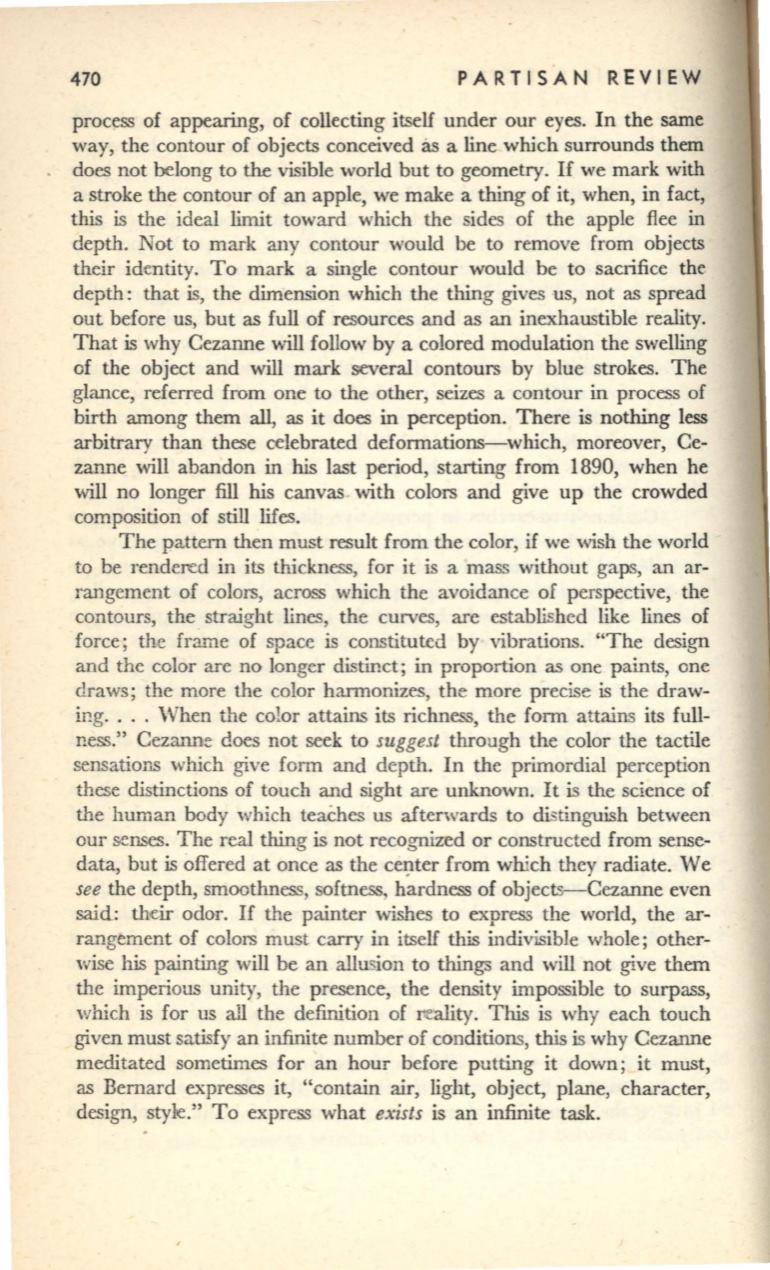
470
PARTISAN REVIEW
process of appearing, of collecting itself under our eyes. In the same
way, the contour of objects conceived as a line whkh surrounds them
does not belong to the visible world but to geometry.
If
we mark with
a stroke the contour of an apple, we make a thing of it, when, in fact,
this is the ideal limit toward which the sides of the apple flee
in
depth. Not to mark any contour would be to remove from objects
their identity. To mark a single contour would be to sacrifice the
depth: that is, the dimension which the u,ing gives us, not as spread
out before us, but as full of resources and as an inexhaustible reality.
That is why Cezanne will follow by a colored modulation the swelling
of the object and will mark several contours by blue strokes. The
glance, referred from one to the other, seizes a contour in process of
birth among them all, as it does in perception. There is nothing less
arbitrary than these celebrated deformations-which, moreover, Ce–
zanne will abandon in his last period, starting from 1890, when he
will no longer fill his canvas with colors and give up the crowded
composition of still lifes.
The pattern then must result from the color, if we wish the world
to be rendePed in its thickness, for it is a mass without gaps, an ar–
rangement of colors, across which the avoidance o£ perspective, the
contours, the straight lines, the curves, are established like lines of
force; the frame of space is constituted by vibrations. "The design
and the color are no longer distinct; in proportion as one paints, one
draws; the more the color harmonizes, the more precise is the draw–
ing.... When the color attains its richness, the form attains its full–
ness." Cezann,e does not seek to
suggest
through the color the tactile
sensations which give form and depth. In the primordial perception
these distinctions of touch and sight are unknown. It is the science of
the human body which teaches us afterwards to distinguish between
our senses. The real thing is not recognized or constructed from sense–
data, but is offered at once as the cel}ter from which they radiate. We
see
the depth, smoothness, softness, hardness of objects- Cezanne even
said: their odor.
If
the painter wishes to express the world, the ar–
rangement of colors must carry in itself this indivisible whole; other–
w'ise his painting will be an allusion to things and will not give them
the imperious unity, the presence, the density impossible to surpass,
which is for us all the definition of ve·ality. This is why each touch
given must satisfy an infinite number of conditions, this is why Cezanne
meditated sometimes for an hour before putting it down; it must,
as Bernard expresses it, "contain air, light, object, plane, character,
design, style." To express what
exists
is an infinite task.


